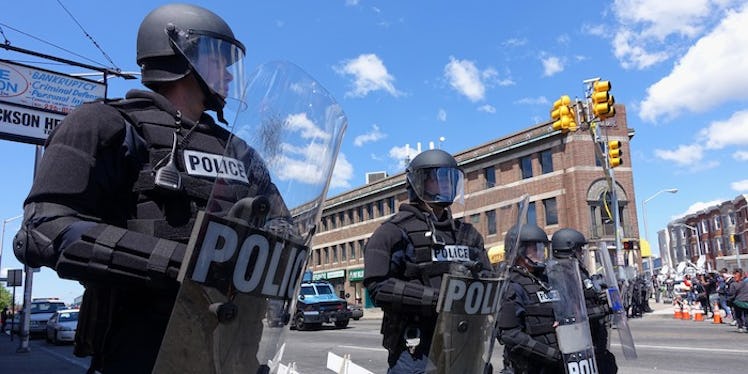
How Militarization Of Police Alters The 'Protect And Serve' Mindset
Their uniforms could be mistaken for a soldier's if it weren't for their "police" patches.
They wear green tops and pants with the US Marine camouflage pattern. They stand in front of a massive armored truck called a BearCat, similar to the mine resistant vehicles they use in international warfare.
But, what are they doing in American cities?
On Saturday, April 25, after following the local news for the better part of the day, I stepped out of my house in Little Italy (a small, family-oriented community in Central Baltimore), to check out the protests against police brutality following the death of Freddie Gray.
I spent most of the afternoon into the evening following the protests from City Hall to the police headquarters, and then up to Oriole Park.
Protesters of all ages, races and genders marched peacefully through the city, hand in hand, seeking to have their voices heard by community officials and police officers alike.
In the days since, the media has shown us some very troubling images of burning buildings and cars, mobs looting local businesses and teenage citizens throwing rocks at police officers.
How exactly did we end up here?
The uproar began when the Baltimore Police Department received “credible information that members of various gangs have entered into a partnership to 'take-out' law enforcement officers.’"
In response to these threats, city officials blockaded the roads surrounding Mondawmin Mall and Frederick Douglass High School, and shut down the school buses and metro stations that take the students home.
As events unfolded and buses were forced to stop and unload, students were met by police officers in full riot gear. With no means of getting home, and facing a blockade of a militarized police force, the students became agitated and began to lash out against the officers.
Numerous local teachers noted that it seemed as though the students were corralled into such rebellious behavior with no way to get home.
How are citizens expected to respond when barricaded by police officers in riot gear when they are presenting no viable threat to public safety? After all, we are talking about local high school students — not enemy combatants.
To fully understand the implications, we must look at the psychological effects of using these resources on American civilians. Norm Stamper, who served as chief of the Seattle Police Department during the 1999 WTO riots, says:
When riot shields are raised, the seemingly simple fact that civilians can't see the cops' faces flips a psychological switch for some citizens in the crowd, and that image acts to dehumanize the officers.
Understandably, citizens depersonalize officers and begin to see them as occupiers, infringing on their territory. This creates an adversarial gap between citizens and officers, and naturally, the citizens will collide with them.
The officers, in essence, have become machine-like invaders who seemingly can no longer be reasoned with.
This psychological divide also goes both ways. The officers, whose usual duties include pulling over speeding drivers and responding to small-scale community disruptions, are often unprepared and under-trained for their newfound responsibilities.
With all branches of the US military facing the greatest downsizing of personnel since the post-World War II era, hoards of downsized veterans are joining police forces for work. Stamper continues:
Now, one of the things that happens is, even when a cop is no longer in that military garb, when they go back to their basic working blues, they don't turn it off. They may, in fact, find themselves behaving the same way they did when they were in that military uniform.
A 2014 White House study showed that 4 percent of the Pentagon's output to police departments is military-grade, including 92,442 small arms, 5,235 Humvees, 617 mine-resistant vehicles and 616 aircrafts, supplemented by similar contributions from the Department of Justice and the Department of Homeland Security.
Since its foundation in 1997, the Defense Department's 1033 Program, whose motto is "from warfighter to crimefighter," has allocated $5.4 billion of military equipment to police forces.
A lot of the surplus assets handed to local departments are completely contrary to the needs of the officers on the ground.
For example, last March, the Los Angeles Police Department received 1,600 camouflage parkas, 500 snowshoes and 132 snow trousers amidst the longest drought in California history.
The ACLU followed this up with an extensive report on the excessive militarization of American policing, concluding that militarization of policing encourages officers to adopt a “warrior” mentality, and think of the people they are supposed to serve as enemies.
Earlier this month, a California assembly committee passed a bill prohibiting local agencies from receiving surplus military equipment, unless the legislative body of the local agency votes to approve the acquisition.
The report cited recent events of police brutality, and distrust between law enforcement and local communities.
In an effort to help regulate the use of this exceptional force by police officers, the White House just requested $263 million to equip police officers nationwide with body cameras to provide a better idea of how these large-scale confrontations are unfolding.
But, opponents argue these practices should be ceased altogether.
As always, there are scenarios in which use of such tactics can be justified. School shootings, hostage situations and terrorist attacks come to mind, but even a large scale domestic incident, like the Boston bombing, was handled mostly without military intervention.
The civilian officers managed to clear thousands of people out of Copley Square rapidly, and preserved the crime scene with no combat air surveillance, specialized bomb-detection gear or military-grade bomb jammers.
Do we need our police departments so heavily equipped?